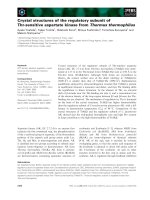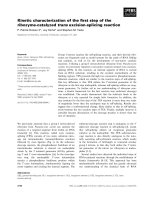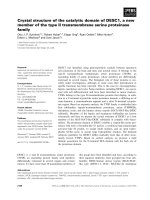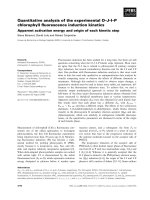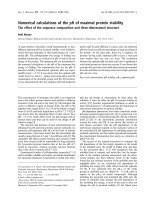Báo cáo khoa học: "AN OVERVIEW OF THE NIGEL TEXT GENERATION GRAMMAR" pptx
Bạn đang xem bản rút gọn của tài liệu. Xem và tải ngay bản đầy đủ của tài liệu tại đây (495.68 KB, 6 trang )
AN
OVERVIEW OF
THE NIGEL TEXT GENERATION GRAMMAR
William C. Mann
USC/Information Sciences institute
4676 Admiralty Way # 1101
Marina del Rey, CA 90291
Abstract
Research on the text generation task has led to
creation of a large systemic grammar of English, Nigel,
which is embedded in a computer program. The
grammar and the systemic framework have been
extended by addition of a semantic stratum. The
grammar generates sentences and other units under
several kinds of experimental control.
This paper describes augmentations of various
precedents in the systemic framework. The emphasis
is on developments which control the text to fulfill a
purpose, and on characteristics which make Nigel
relatively easy to embed in a larger experimental
program.
1 A Grammar for Text Generation - The
Challenge
Among the various uses for grammars, text generation at
first seems to be relatively new. The organizing goal of text
generation, as a research task, is to describe how texts can be
created in fulfillment of text needs. 2
Such a description must relate texts to needs, and so must
contain a functional account of the use and nature of language, a
very old goal. Computational text generation research should be
seen as simply a particular way to pursue that goal.
As part of a text generation research project, a grammar of
English has been created and embodied in a computer program.
This grammar and program, called Nigel, is intended as a
component of a larger program called Penman. This paper
introduces Nigel, with just enough detail about Penman to show
Nigel's potential use in a text generation system.
IThis research was Supported by the Air Force Office of Scientific
Research
contract NO. F49620.79-C-0181. The views and conclusions contained =n this
document are those of the author and should not be interpreted as necessarily
representing the Official polic=es or endorsements, either expressed or implied, of
the Air Force Office Of S(;ientific Research of the U.S. Government.
2A text need is the earliest recognition on the part of the speaker that
the
=mmeciiate situation is orle in which he would like to produce speech. In this report
we will alternate freely between the terms speaker, writer and author, between
hearer and reader, and between speech and text This is s=mpty partial
accommodation of preva=ling jargon; no differences are intended.
1.1 The Text Generation Task as a Stimulus for Grammar
Design
Text generation seeks to characterize the use of natural
languages by developing processes (computer programs) which
can create appropriate, fluent text on demand. A representative
research goal would oe to create a program which could write a
text that serves as a commentary on a game transcript, making the
eventsof the game understandable. 3
The guiding aims in the ongoing des=gn of the Penman text
generation program are as follows:
1. To learn, in a more specific way than has prewously
been achieved, how appropriate text can be created
in response to text needs.
2. To identify the dominant characteristics which make a
text appropriate for meeting its need.
3. To develop a demonstral~le capacity to create texts
which meet some identifiable practical class of text
needs.
Seeking to fill these goals, several different grammatical
frameworks were considered. The systemic framework was
chosen, and it has proven to be an entirely agreeable choice.
Although it is relatively unfamiliar to many American researchers.
it has a long history of use in work on concerns which are central
tO text generation. It was used by Winograd in the SHRDLU
system, and more extensively by others since [Winograd 72. Davey
79, McKeown 82. McDonald 80]. A recent state of the art survey
identifies the systemic framework as one of a small number of
linguistic frameworks which are likely to be the basis for
significant text generation programs in th~s decade {Mann 82a}.
One of the principal advantages of the systemic framework
iS its strong emphasis on "functional" explanations of
grammatical phenomena. Each distinct kind of grammatical entity
iS associated with an expression of what it does for the speaker.
so that the grammar indicates not only what is possible but why it
would be used. Another is its emphasis on principled, iustified
descriptions of the choices which the grammar offers, i.e. all of its
optionality. Both of these emphases support text generation
programming significantly. For these and other reasons the
systemic framework waS Chosen for Nigel.
Basic references on the systemic framework include:
[Berry 75, Berry 77, Halliday 76a, Halliday 76b, Hudson
3This was accomplished in work Py Anthony Davey [Davey 79]; [McKeown 821 is
a comoaraOle more recent study it} whlcR the generated text clescrioed structural
and definitional aspects of a data base.
79
76, Hatliday 81, de Joia 80, Fawcett 80]. 4
1.2 Design Goals for the Grammar
Three kinds of goals have guided the work of creating
Niget.
1.To specify in total detail how the systemic
framework
can generate syntactic units, using the
computer as the medium of experimentation.
2. To develop a grammar of English which is a good
representative of the systemic framework and useful
for demonstrating text generation on a particular task.
3. To specify how the grammar can be
regulated
effectively by the prevailing text need in its
generation activity.
Nigel is intended to serve not only as a part of the Penman
system, but also eventually as a portable generational grammar, a
component of future research systems investigating, and
developing text generation.
Each of the three goals above has led to a different kind of
activity in developing Nigel and a different kind of specification in
the resulting program, as described below. The three design
goals have not all been met. and the work continues.
1. Work on the first goal, specifying the framework, is
essentially finished (see section 2.1). The lnterlisp
program is stable and reliable for its developers.
2. Very substantial progress has been made on creating
the grammar of English; although the existing
grammar is apparently adequate for some text
generation tasks, some additions are planned.
3. Progress on the third goal, although gratifying, is
seriously incomplete. We have a notation and a
design method for relating the grammar to prevailing
text needs, and there are worked out examples which
illustrate the methods the demonstration ~aper in
[Mann 83](see section 2.3.)
2 A
Grammar for Text Generation
-
The
Design
2.1 Overview of Nigel's Design
The creation of the Nigel program has required
evolutionary rather than radical revisions in systemic notation,
largely in the direction of making well-precedented ideas more
explicit or detailed. Systemic notation deals principally with three
kinds of entities: 1} systems, 2) realizations of systemic choices
(including function structures), and 3) lexical items. These three
account for most of the notational devices, and the Nigel program
has separate parts for each.
4This work would not have been possible wtthout the active palliclpatlon of
Christian MattNessen, and the participation and past contributions of
Michael
Halliday and other system=c=sts.
Comparing the systemic functional approach to a
structural approach such as context-free grammar, ATNs or
transformational grammar, the differences in style (and their
effects on the programmed result) are profound. Although it is not
possible to compare the approaches in depth here, we note
several differences of interest to people more familiar with
structural approaches:
• Systems, which are most like structural rules, do not
specify the order of constituents. Instead they are
used to specify sets of features to be possessed by
the grammatical construction as a whole.
2. The grammar typically pursues several independent
lines of reasoning (or specification) whose results are
then combined. This is particularly difficult to do in a
structurally oriented grammar, which ordinarily
expresses the state of development of a unit in terms
of categories of constituents.
3. In the systemic framework, all variability of the
structure of the result, and hence all grammatical
control, is in one kind of construct, the system. In
other frameworks there is often variability from several
sources: optional rules, disjunctive options within
rules, optional constituents, order of application and
so forth. For generation these would have to be
coordinated by methods which lie outside of the
grammar, but in the systemic grammar the
coordination problem does not exist.
2.1 .1 Systems and Gates
Each system contains a set of alternatives• symbols called
grammatical features. When a system is entered, exactly one
of its grammatical features must be chosen. Each system also has
an input expression, which encodes the conditions under which
the system is entered 5 Outing the generation, the Dr0gram keeps
track of the selection expression, the set of features which have
been chosen up to that point. Based on the selection expression.
the program invokes the realization operations which are
associated with each feature chosen.
In addition to the systems there are Gates. A gate can be
thought of as an input expression which activates a particular
grammatical feature, without choice. 6 These grammatical features
are used just as those chosen in systems. Gates are most often
used to perform realization in response to a collection of features. 7
5Input expressions are BooLean expressions of features, without negation, ~.e.
they are composed entirely of feature names, together with And. Or and
0arentheses. (See the figures in the demonstration paper tn IMann 8.3} for
examples.)
6See the figure entitled Transitivity I =n [Mann 83} for examDles and further
discussion of the roles of
gates.
7Bach realization ot~erat=on is associated with just one feature, there are no
realizat¢on
operations which depend on more than one feature, and no rules
corresponding to Hudson's function reah;'ation rules. The gates facihtate
elimiqating this category of rules, with a net effect that the notation is more
homogeneous.
80
2.1.2 Realization Operators
There are three groups of realization operators: those that
build structure (in terms of grammatical functions), those that
constrain order, and those that associate features with
grammatical functions.
1. The realization operators which build structure are
Insert, Conflate, and Expand. By repeated use of
the structure building functions, the grammar is able
to construct sets of function bUndles, also called
fundles. None of them are new to the systemic
framework.
2. Realization operators which constrain order are
Partition, Order, OrderAtFront and OrderAtEnd.
Partition constrains one function (hence one fundle)
to be realized to the left of another, but does not
constrain them to be adjacent. Order constrains just
as Partition does, and in addition constrains the two tO
be realized adjacently. OrderAtFront constrains a
function to be realized as the leftmost among the
daughters of its mother, and OrderAtEnd
symmetrically as rightmost. Of these, only Partition is
new to the systemic framework.
3. Some operators associate features with functions.
They are Preselect, which associates a grammatical
feature with a function (and hence with its fundle);
Classify, which associates a lexical feature with a
function: OutClassify, which associates a lexical
feature with a function in a preventive way; and
Lexify, which forces a particular lexical item to be
used to realize a function. Of these, OutClassify and
Lexi~ are new, taking up roles previously filled by
Classify. OutClaasify restricts the realization of a
function (and hence fundle) to be a lexical item which
does not bear the named feature. This is useful for
controlling items in exception categories (e.g.
reflexives) in a localized, manageable way. Lexify
allows the grammar to force selection of a particular
item without having a special lexical feature for that
purpose.
In addition to these realization operators, there =s a set of
Default Function Order Lists. These are lists of functions
which will be ordered in particular ways by Nigel. provided that the
functions on the lists occur in the structure, and that the
realization operators have not already ordered those functions. A
large proportion of the constraint of order is performed through
the use of these lists.
The realization operations of the systemic frameworK,
especially those having to do with order, have not been specified
so explicitly before.
2.1.3 The Lexicon
The lexicon is defined as a set of arbitrary symbols, called
word names, such as "budten", associated wtth symbols called
spellings, the lexical items as they appear in text. In order to
keep Nigel simple during its early development, there is no formal
provision for morphology or for relations between items which
arise from the same root.
Each word name has an associated set of lexical
features.
Lexify selects items by word name; Classify and
OutClassify operate on sets of items in terms of the lexicat
features.
2.2
The Grammar and Lexicon of English
Nigel's grammar is partly based on published sources, and
is partly new. It has all been expressed in a single homogeneous
notation, with consistent naming conventions and much care to
avoid reusing names where identity is not intended. The grammar
is organized as a single network, whose one entry point is used for
generating every kind of unit. 8
Nigers lexicon is designed for test purposes rather than for
coverage of any particular generation task. It currently recogmzes
130 texical features, and it has about 2000 texical items in about
580 distinct categories (combinations of features).
2.3 Choosers - The Grammar's Semantics
The most novel part of Nigel is the semantics of :Re
grammar. One of the goals identified above was to "s~ecify '~ow
the grammar can be regulated effectively by the prevailing text
need." Just as the grammar and the resuiting text are ooth very,
complex, so is the text need. In fact. grammar and text complexity
actually reflect the prior complexity of the text nee~ ',vh~c~ ~ave
rise to the text. The grammar must respond selectwely to those
elements of the need which are represente~ by the omt Demg
generated at the moment.
Except for lexical choice, all variability in Nigers generated
result comes from variability of choice in the grammar.
Generating an appropriate s[ructure consists entirely in making
the choices in each system appropriately. The semantics of the
grammar must therefore be a semantics of cno~ces in the
individual systems; the choices must be made in each system
according to the appropriate elements of the prevailing need.
In Nigel this semantic control is localized ',o the systems
themselves. For each system, a procedure is defined ,.vh~ch can
declare the appropriate choice in the system. When the system is
entered, the procedure is followed to discover the appropriate
choice. Such a procedure is called a chooser (or "choice
expert".) The chooser is the semantic account of the system, me
description of the circumstances under wnpch each choice is
approoriate.
To specify the semantics of the choices, we needed a
notation for the choosers as procedures. This paper describes
that notation briefly and informally. Its use is exemplified in the
Nigel demonstration [Mann C:x3j and developed in more detail ~n
another report [Mann 82b].
To gain access to the details of the need. the choosers
must in some sense ask questions about particular entities. For
example, to decide between the grammatical features Singular
and Plural in creating a NominalGroup. the Number chooser (the
8At the end of 1982. N,gel contained about 220 systems, with all ot the
necessary realizations speclfiecL tt ts thus the largest systemic grammar in a single
notation, and possibly the largest grammar of a natural language in any of the
functional linguJstic traditions. Nigel ~S ~rogrammed in INTEF:tLISP
81
chooser for the Number system, where these features are the
options) must be able to ask whether a particular entity (already
identified elsewhere as the entity the NominalGroup represents) is
unitary or multiple. That knowledge resides outside of Niget, in the
environment.
The environment is regarded informally as being
composed of three disjoint regions:
1. The
Knowledge Base,
consisting of information
which existed prior to the text need;
2. The
Text Plan,
consisting of information which was
created in response to the text need, but before the
grammar was entered;
3. The Text Services, consisting of information which
is available on demand, without anticipation.
Choosers must have access to a stock of symbols
representing entities in the environment. Such symbols are called
hubs.
In the cOurse of generation, hubs are associated with
grammatical functions; the associations are kept in a
Function
Association
Table, which is used to reaccess information in the
environment. For example, in choosing pronouns the choosers
will ask Questions about the multiplicity of an entity which is
associated with the THING function in the Function Associat=on
Table. Later they may ask about the gender of the same entity.
again accessing it through its association with THING. This use of
grammatical functions is an extension of prewous uses.
Consequently, relations between referring phrases and the
concepts being referred to are captured in the Function
Association Table. For example, the function representing the
NominalGroup as a whole is associated with the hub whictl
represents the thing being referred to in the environment.
Similarly for possessive determiners, the grammatical function for
the determiner is associated with the hub for the possessor.
It is convenient to define choosers in such a way that they
have the form of a tree. For any particular case, a single path of
operations is traversed. Choosers are defined principally in terms
of the following Operations:
1. Ask presents an inquiry to the environment. The
inquiry has a fixed predetermined set of possible
responses, each corresponding to a branch of the
path in the chooser,
2. Identify ~resents an inquiry to the environment. The
set of responses is open-ended. The response is put
in the Function Association Table. associated with a
grammatical function which is given (in addition to the
inquiry) as a parameter tO the Identify operator. 9
3. Choose declares a choice,
4. CopyHub transfers an association of a hub from one
grammatical function tO another. 1°
9See the demonstration paper in [Mann 8,3} for an explanation and example of
its
use
10There are three athers whtCh have some linguistic slgnihcance: Pledge,
TermPle~:lge, and Cho~ceError. These are necessary but do not Play a central rote,
They are named here lust to indicate that the chooser notation ~s very s=m~le.
Choosers obtain information about the immediate
circumstances in which they are generating by presenting
inquiries to the environment. Presenting inquiries, and receiving
replies constitute the only way in which the grammar and its
environment interact.
An inquiry consists of an inquiry operator and a
sequence of inquiry parameters. Each inquiry parameter is a
grammatical function, and it represents (via the Function
Association Table) the entities in the environment which the
grammar is inquiring about. The operators are defined in such a
way that they have both formal and informal modes of expression.
Informally. each inquiry is a predefined question, in English, which
represents the issue that the inquiry is intended to resolve for any
chooser that uses it. Formally. the inquiry shows how systemic
choices depend on facts about particular grammatical functions,
and in particular restricts the account of a particular choice to be
responsive to a well-constrained, well-identified collection of facts.
Both the informal English form of the inquiry and the
corresponding formal expression are regarded as parts of the
semantic theory expressed by the choosers which use the inquiry.
The entire collection of inquiries for a grammar ~s a definition of
the semantic scope to which the grammar is responsive at its [evet
of delicacy.
Figure 1 shows the chooser for the ProcessType system.
whose grammat=cal feature alternatives are Relational, Mental,
Verbal and Material.
Notice that in the ProcessType chooser, although there are
only four possible choices, there are five paths through the
chooser from the starting point at the too, because Mental
processes can be identified in two different ways: those which
represent states of affairs and those which do not. The number of
termination points of a chooser often exceeds the number of
choices available.
Table 1 shows the English forms of the Questions being
asked in the ProceasType chooser. (A word ~n all cap.tats names
a grammatical function which is a oarameter of the inquiry,)
Table 1: English Forms of the tncluiry Operators for the
ProcessType Chooser
StaticConditionQ Does the process PROCESS represent a static
condition or state of being?
VerbalProcessQ Does the process PROCESS represent
symbolic communication of a Kind which could
have an addressee?
MentalProoessQ Is PROCESS a process of comprehension.
recognition, belief, perception, deduction,
remembering, evaluation or mental reaction?
The sequence of incluiries which the choosers present to
the environment, together with its responses, creates a dialogue.
The unit generated can thus be seen as being formed out of a
negotiation between the choosers and the environment. This is a
particularly instructive way to view the grammar and its semantics,
since it identifies clearly what assumptions are being made and
what dependencies there are between the unit and the
environment's representation of the text need. (This is the kind of
dialogue represented in the demonstration paper in [Mann 83].)
82
??(Static Condition 0 P~
/ \
• : : Matedal
Figure
1 : The Chooser of the ProcessType system
The grammar performs the final steps in the generation
process. It must complete the surface form of the text, but there is
a great deal of preparation necessary before it is appropriate for
the grammar tO start its work. Penman's design calls for many
kinds of activities under the umbrella of "text planning" to provide
the necessary support. Work on Nigel is proceeding in parallel
with other work intended to create text planning processes.
3 The Knowledge Representation of the
Environment
Nigel does not presume that any particular form Of
knowledge representation prevails in the environment. The
conceptual content of the environment is represented in the
Function Association Table only by single, arbitrary,
undecomposable symbols, received from the environment; the
interface is designed so that environmentally structured
responses do not occur. There is thus no way for Nigel to tell
whether the environment's representation is, for example, a form
of predicate calculus or a frame-based notation.
Instead, the environment must be able to respond to
incluiries, which requires that the inquiry operators be
~mplemented. It must be able to answer inquiries about
multiplicity, gender, time, and so forth, by whatever means are
appropriate to the actual environment.
AS a result, Nigel is largely independent of the
environment's notation. It does not need to know how to search,
and so it is insulated from changes .in representation. We expect
that Nigel will be transferable from one application to another with
relatively little change, and will not embody covert knowledge
about particular representation techniques.
4 Nigel's Syntactic Diversity
This section provides a set of samples of Niget's syntactic
diversity: aJl of the sentence and clause structures in the Abstract
of this paper are within Nigers syntactic scope.
Following a frequent practice in systemic linguistics
(introduced by Halliday), the grammar provides for three relatively
independent kinds of specification of
each
syntactic unit: the
Ideational
or logical content, the
Interpersonal
content (attitudes
and relations between the speaker and the unit generated) and the
Textual
content. Provisions for textual control are well elaborated,
and so contribute significantly to Nigel's ability to control the flow
of the reader's attention and fit sentences into larger un=ts of text.
5
Uses for Nigel
The activity of defining Nigel, especially its semantic parts.
is productive in its own right, since it creates interesting
descriotions and proposals about the nature of English and ti~e
meaning of syntactic alternatives, as well as new notaticnal
devices, t~ But given Niget as a program, contaimng a full
complement of choosers, inquiry operators and related entities,
new possibilities for investigation also arise.
Nigel provides the first substantial opportunity to test
systemic grammars to find out whether they produce unintended
combinations of functions, structures or uses of lex~cal items.
Similarly, it can test for contradictions. Again. Nigel provides the
first substantial opportunity for such a test. And such a test is
necessary, since there appears to be a natural tendency to write
grammars with excessive homogeneity, not allowing for possible
exception cases. A systemic functional account can also be
111t tS our intention eventually to make Nigel avaJlal~le for teaching, research,
development and computational application
83
tested in Niget by attempting to replicate part=cular natural texts a
very revealing kind of experimentation. Since Nigel provides a
consistent notation and has been tested extensively, it also has
some advantages for educational and linguistic research uses.
On another scale, the whole project can be regarded as a
single experiment, a test of the functionalism of the systemic
framework, and of its identification of the functions of English.
In artificial intelligence, there is a need for priorities and
guidance in the design of new knowledge representation
notations. The inquiry operators of Nigel are a particularly
interesting proposal as a set of distinctions already embodied in a
mature, evolved knowledge notation, English, and encodable in
other knowledge notations as well. To take just a few examples
among many, the inquiry operators suggest that a notation for
knowledge should be able to represent objects and actions, and
should be able to distinguish between definite existence,
hypothetical existence, conjectural existence and non.existence
of actions, These are presently rather high expectations for
artificial intelligence knowledge representations.
6
Summary
As part of an effort to define a text generation process, a
programmed systemic grammar called Nigel has been created.
Systemic notation, a grammar of English, a semantic notation
which extends systemic notation, and a semantics for English are
all included as distinct parts of Nigel. When Nigel has been
completed
it
will
be useful as a research tool in artificial
intelligence and linguistics, and as a component in systems which
generate text.
References
[Berry 75] Berry, M.,
Introduction to Systemic Linguistics:
Structures and Systems,
B. T. Batsford, Ltd., London, 1975.
[Berry 77] Ber~, M.,
Introduction to Systemic Lingusstics; Levels
and Links,
8. T. Batsford, Ltd London, 1977.
[Davey 79] Davey, A.,
Discourse Production,
Edinburgh University
Press, Edinburgh. 1979.
[de Joia 80] de JoJa. A and A. Stenton,
Terms in Systemic
Linguistics,
Batsford Academic and Educational. Ltd.,
London, 1980.
[Fawcett 80] Fawcett, R. P.,
Exeter Lmgusstic Studies
Volume 3:
Cognitive Linguistics and Social Interaction,
Julius Groos
Verlag Heidelberg and Exeter University, 1980.
[Halliday 76a] Halliday, M. A. K and R. Hasan,
Cohesion in
English,
Longman, London, t976. English Language Series.
Title No. 9.
[Halliday 76b] Halliday, M. A. K.,
System and Function in
Language,
Oxford University Press, London, 1976.
[Halliday 81] Halliday, M.A.K., and J. R. Martin (eds.),
Readings in
Systemic Linguisfics,
Batsford, London, 1981.
[Hudson 76] Hudson, FI. A.,
Arguments for a
Non.Transformational Grammar,
University of Chicago Press,
Chicago, 1976.
[Mann 82a] Mann, W. C., et. al., "Text Generation,"
American
Journal of Computational Linguistics
8, (2), April-June 1982
,62-69.
[Mann 82b] Mann, W. C.,
The Anatomy of a Systemic Choice,
USC/Information Sciences Institute, Marina del Rey, CA,
RR.82-104, October 1982.
[Mann 8,3} Mann, W. C., and C. M. I. M. Matthiessen, "A
demonstration of the Niget text generation computer
program," in Nigeh A Systemic Grammar for Text Generation.
USC/Information Sciences
Instrtute,
RR.83-105, February
1983. This paper will also appear in a forthcoming volume of
the
Advances in Discourse Processes Ser~es,
R. Freedle led.):
Systemic Perspectives on Discourse: Selected Theoretical
Papers from the 9th International Systemic Workst~op
to be
published by Ablex.
[McDonald 80} McDonald, D. D.,
Natural Language Rroctuction as
a Process
of
Decision.Making Under Constraints,
Ph.D. thesis, Massachusetts Institute of Technology, Dept. of
Electricial Engineering and Computer Science, 1980. To
appear as a technical report from the MIT Artificial
Intelligence Laboratory.
[McKeown 82] McKeown. K.R.,
Generating Natural Language
Text in Response to Questions at:out Dataoase Structure.
Ph.O. thesis, University of Pennsylvania. 1982.
[Winograd 72] Winograd. T
Understanding Natural Language.
Academic Press, Edinburgh. 1972.
84


